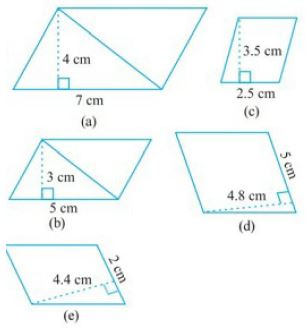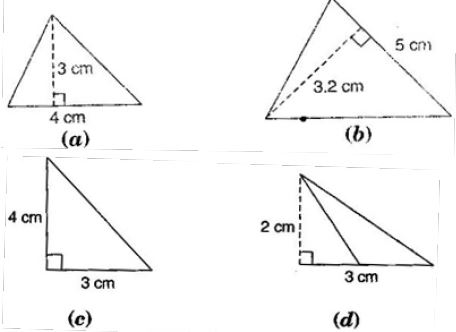Class 6 - Mathematics
Chapter - Perimeter and Area : Exercise 11.2

Top Block 1
Question : 1.Find the area of each of the following parallelograms:

Answer :
We know that the area of parallelogram = base x height
(a) Here base = 7 cm and height = 4 cm
∴ Area of parallelogram = 7 x 4 = 28cm2
(b) Here base = 5 cm and height = 3 cm
∴ Area of parallelogram = 5 x 3 = 15 cm2
(c) Here base = 2.5 cm and height = 3.5 cm
∴ Area of parallelogram = 2.5 x 3.5 = 8.75 cm2
(d) Here base = 5 cm and height = 4.8 cm
∴ Area of parallelogram = 5 x 4.8 = 24 cm2
(e) Here base = 2 cm and height = 4.4 cm
∴ Area of parallelogram = 2 x 4.4 = 8.8 cm2
Question : 2.Find the area of each of the following triangles:

Mddle block 1
Answer :
We know that the area of triangle = ½ x base x height
(a) Here, base = 4 cm and height = 3 cm
∴ Area of triangle = ½ x 4 x 3 = 6 cm2
(b) Here, base = 5 cm and height = 3.2 cm
∴ Area of triangle = ½ x 5 x 3.2 = 8 cm2
(c) Here, base = 3 cm and height = 4 cm
∴ Area of triangle = ½ x 3 x 4 = 6cm2
(d) Here, base = 3 cm and height = 2 cm
∴ Area of triangle = ½ x 3 x 2 = 3cm2
Question : 3.Find the missing values:
| S. No. | Base | Height | Area of the parallelogram |
|---|---|---|---|
| a. | 20 cm | 246 cm2 | |
| b. | 15 cm | 154.5cm2 | |
| c. | 84 cm | 48.72 cm2 | |
| d. | 15.6 cm | 16.38 cm2 |
Answer :
We know that the area of parallelogram = base x height
(a) Here, base = 20 cm and area = 246 cm2
∴ Area of parallelogram = base x height
⇒ 246 = 20 x height ⇒ height = 246⁄20= 12.3 cm
(b) Here, height = 15 cm and area = 154.5 cm2
∴ Area of parallelogram = base x height
⇒ 154.5 = base x 15 ⇒ base = 154.5⁄15= 10.3 cm
(c) Here, height = 8.4 cm and area = 48.72cm2
∴ Area of parallelogram = base x height
⇒ 48.72 = base x 8.4 ⇒ base = 48.72⁄8.4= 5.8 cm
(d) Here, base = 15.6 cm and area = 16.38 cm2
∴ Area of parallelogram = base x height
⇒ 16.38 = 15.6 x height ⇒ height = 16.38⁄15.6 = 1.05 cm
Thus, the missing values are:
| S. No. | Base | Height | Area of the parallelogram |
|---|---|---|---|
| a. | 20 cm | 12.3 cm | 246 cm2 |
| b. | 10.3 cm | 15 cm | 154.5cm2 |
| c. | 5.8 cm | 84 cm | 48.72 cm2 |
| d. | 15.6 cm | 1.05 cm | 16.38 cm2 |
Question : 4.Find the missing values:
| Base | Height | Area of triangle |
|---|---|---|
| 15 cm | — | 87 cm2 |
| — | 31.4 mm | 1256 mm2 |
| 22 cm | — | 170.5cm2 |
Answer :
We know that the area of triangle = ½ x base x height
In first row, base = 15 cm and area = 87 cm2
∴ 87 = ½ x 15 x height
⇒height = (87 x 2)⁄5 = 11.6 cm
In second row, height = 31.4 mm and area = 1256 mm2
∴ 1256 = ½ x base x 31.4 ⇒ base = (1256 x 2)⁄31.4= 80 mm
In third row, base = 22 cm and area = 170.5 cm2
∴ 170.5 = ½ x 22 x height
⇒height = (170.5 x 2)⁄22= 15.5 cm
Thus, the missing values are:
| Base | Height | Area of triangle |
|---|---|---|
| 15 cm | 11.6 cm | 87 cm2 |
| 80 mm | 31.4 mm | 1256 mm2 |
| 22 cm | 15.5 cm | 170.5cm2 |
Question : 5.PQRS is a parallelogram. QM is the height from Q to SR and QN is the height from Q to PS. If SR = 12 cm and QM = 7.6 cm. Find:
(a) the area of the parallelogram PRS
(b) QN, if PS = 8 cm
Answer :
Given: SR = 12 cm, QM= 7.6 cm, PS = 8 cm.
(a) Area of parallelogram = base x height
= 12 x 7.6 = 91.2 cm2
(b) Area of parallelogram = base x height
⇒ 91.2 = 8 x QN ⇒ QN = 91.2⁄8 = 11.4 cm
Question : 6.DL and BM are the heights on sides AB and AD respectively of parallelogram ABCD. If the area of the parallelogram is 1470cm2, AB = 35 cm and AD = 49 cm, find the length of BM and DL.

Answer :
Given: Area of parallelogram = 1470cm2
Base (AB) = 35 cm and base (AD) = 49 cm
Since Area of parallelogram = base x height
⇒ 1470 = 35 x DL ⇒ DL = 1470⁄35
⇒ DL = 42 cm
Again, Area of parallelogram = base x height
⇒ 1470 = 49 x BM ⇒ BM = 1470⁄49
⇒ BM = 30 cm
Thus, the lengths of DL and BM are 42 cm and 30 cm respectively.
Question : 7.ΔABC is right angled at A. AD is perpendicular to BC. If AB = 5 cm, BC = 13 cm and AC = 12 cm, find the area of ΔABC. Also, find the length of AD.

Answer :
In right angles triangle BAC, AB = 5 cm and AC = 12 cm
Area of triangle = ½ x base x height = ½ x AB x AC
= ½ x 5 x 12 = 30cm2
Now, in ΔABC,
Area of triangle ABC = ½ x BC x AD
⇒ 30 = ½ x 13 x AD ⇒ AD = (30×2)⁄13= 60⁄13cm
Question : 8.ΔABC is isosceles with AB = AC = 7.5 cm and BC = 9 cm. The height AD from A to BC, is 6 cm. Find the area of ΔABC. What will be the height from C to AB i.e., CE?

Answer :
In ΔABC, AD = 6 cm and BC = 9 cm
Area of triangle = ½ x base x height = ½ x BC x AD
= ½ x 9 x 6 = 27cm2
Again, Area of triangle = ½ x base x height = ½ x AB x CE
⇒ 27 = ½ x 7.5 x CE ⇒ CE = (27×2)⁄7.5
⇒ CE = 7.2 cm
Thus, height from C to AB i.e., CE is 7.2 cm.

